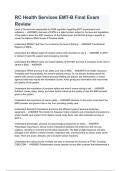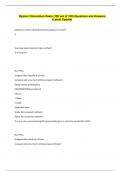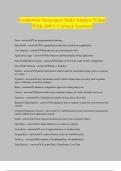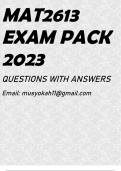RC
Health
Services
EMT-B
Final
Exam
Review
Level
of
Government
responsible
for
EMS
regulation
regarding
EMT
requirements
and
violations.
-
ANSWER
Licensure
of
EMTs
is
a
state
function
subject
to
the
laws
and
regulations
of
the
state
in
which
the
EMT
practices.
At
the
federal
level,
the
NHTSA
brings
in
experts
to
create
the
National
EMS
Scope
of
Practice
Model.
Understand
NREMT
and
how
it
is
involved
in
the
level
of
training.
-
ANSWER
The
National
Registry
of
EMTs.
Understand
the
different
types
of
medical
control
and
how/when
to
use
it.
-
ANSWER
An
EMT
is
trained
in
basic
life
support
and
emergency
services.
Understand
the
different
roles
and
responsibilities
of
the
EMT
and
how
it
compares
to
the
role
of
others
in
EMS.
-
ANSWER
Understand
HIPAA
and
how
it
can
affect
your
role
in
EMS.
-
ANSWER
The
Health
Insurance
Portability
and
Accountability
Act
ensures
patient
privacy.
Do
not
discuss
findings
about
the
patient
with
anyone
except
medical
personal
treating
the
patient,
law
enforcement,
or
social
agencies
that
may
require
the
information
by
law.
Avoid
giving
any
information
that
may
reveal
the
identity
of
the
patient.
Understand
the
importance
of
personal
safety
and
what
it
means
during
a
call.
-
ANSWER
Nutrition,
stress,
sleep,
family,
and
other
factors
influence
the
quality
of
care
the
EMS
provider
gives
to
the
patient.
Understand
the
importance
of
scene
safety.
-
ANSWER
Hazards
on
the
scene
could
harm
the
EMS
provider
and
prevent
him
or
her
from
providing
quality
care
Understand
Standard
Precautions
and
know
the
different
types
of
personal
protective
equipment.
-
ANSWER
The
Center
for
Disease
Control
created
a
set
of
standard
precautions
to
protect
health
care
workers
from
objects,
blood,
body
fluids,
and
other
potential
sources
of
germs.
Understand
physiologic,
physical
and
psychological
responses
to
stress.
-
ANSWER
Physiologic
responses
to
stress
involve
interactions
between
the
endocrine
and
nervous
systems,
resulting
in
chemical
and
physical
responses.
The
fight-or-flight
response
includes
changes
to
the
dilation
of
blood
vessels,
respiration
rate,
and
blood
flow
to
certain
areas
of
the
body.
There
are
acute,
delayed,
and
cumulative
stress
reactions.
Understand
the
various
levels
of
stress
and
how
to
minimize
the
chances
of
PTSD,
including
CISD/CISM.
-
ANSWER
Posttraumatic
stress
disorder
occurs
after
a
person
has
experienced
a psychologically
distressing
event,
and
usually
manifests
in
the
form
of
depression,
startle
reactions,
flashback
phenomena,
and
dissociative
episodes.
Critical
incident
stress
management
was
created
to
decrease
the
likelihood
of
PTSD.
It
can
take
the
form
of
a
formal
debriefing
(CISD)
or
of
an
onsite
assessment
for
symptoms
of
PTSD.
Know
the
different
components
of
the
grieving
process.
-
ANSWER
Denial,
Anger/Hostility,
Bargaining,
Depression,
and
Acceptance.
These
stages
can
happen
at
varying
times
in
different
orders
Understand
the
difference
between
expressed
consent,
implied
consent
and
involuntary
consent.
-
ANSWER
Expressed
consent
is
when
the
patient
verbally
or
otherwise
acknowledges
that
he
or
she
wants
you
to
provide
care.
Implied
consent
applies
when
the
patient
is
unconscious
or
otherwise
incapable
of
making
a
rational,
informed
decision
about
care.
The
law
assumes
that
the
patient
would
give
consent
if
able
to.
Involuntary
consent
applies
to
patients
who
are
incapable
of
making
rational
decisions
about
care
due
to
injury
or
mental
illness.
This
type
of
consent
usually
comes
from
the
legal
guardian
of
the
person.
Differentiate:
advanced
directives
versus
do
not
resuscitate
(DNR)
orders
and
understand
what
happens
in
the
place
of
no
DNR
present
at
the
scene.
-
ANSWER
An
advanced
directive
is
a
written
document
that
specifies
medical
treatment
for
a
competent
patient,
should
he
or
she
be
unable
to
make
rational
decisions.
They
can
be
orders
for
both
providing
and
withholding
care.
A
DNR
orders
medical
providers
to
withhold
CPR
and
ALS,
but
does
not
prevent
them
from
providing
BLS.
Without
a
DNR
healthcare
providers
will
begin
to
attempt
resuscitation
should
the
patient's
heart
stop.
Understand
the
difference
between
a
living
will
and
a
health
care
directive
-
ANSWER
Living
wills
and
other
advance
directives
are
written,
legal
instructions
regarding
your
preferences
for
medical
care
if
you
are
unable
to
make
decisions
for
yourself.
Advance
directives
guide
choices
for
doctors
and
caregivers
if
you're
terminally
ill,
seriously
injured,
in
a
coma,
in
the
late
stages
of
dementia
or
near
the
end
of
life.
Understand
the
difference
between
libel,
slander,
assault,
battery,
abandonment
and
negligence
and
their
implications.
-
ANSWER
Abandonment
occurs
when
the
medical
provider
leaves
the
patient
alone
or
in
the
care
of
someone
who
is
not
competent
in
the
care
of
the
patient.
This
is
done
without
the
consent
of
the
patient.
Assault
is
placing
the
patient
in
fear
or
immediate
bodily
harm.
Battery
is
unlawfully
touching
the
patient,
including
providing
care
without
consent.
Negligence
is
the
failure
to
provide
the
same
care
that
another
equally
competent
health
care
provider
would
have
provided.
Defamation
is
the
communication
of
false
information
that
damages
the
reputation
of
a
person.
Libel
is
written
and
slander
is
spoken
defamation.
Understand
the
components
that
are
needed
to
prove
negligence.
-
ANSWER
In
order
to
prove
negligence
there
must
be
a
duty,
breach
of
duty,
damages,
and
causation.
The
plaintiff
can
use
res
ipsa
inquisitor
and
negligence
per
se
to
win
a
case
of
negligence. Understand
when
it
is
appropriate
to
forcibly
restrain
a
patient.
-
ANSWER
Forcible
restrain
is
necessary
when
the
patient
is
combative
and
poses
a
risk
to
himself
or
others.
This
must
be
in
agreement
with
the
laws
of
the
specific
state
you
are
operating
within.
Understand
when
it
is
appropriate
to
legally
release
patient
information.
-
ANSWER
HIPAA
protects
protected
health
information
(PHI).
It
is
legally
permissible
to
release
this
information
to
other
healthcare
providers
who
are
also
treating
the
patient.
PHI
can
be
used
for
training
of
internal
quality
improvement
as
long
as
any
information
relating
to
the
identity
of
the
patient
is
protected.
The
court
may
require
you
to
disclose
information
such
as
in
child
abuse
cases.
Only
the
minimum
amount
of
information
necessary
should
be
released.
Understand
special
considerations
and
how
to
communicate
with
various
types
of
patients
(e.g.,
hearing
impaired,
visually
impaired,
young,
elderly,
non-English
speaking,
etc.)
-
ANSWER
Older
patients
should
be
assumed
to
be
able
to
think
clearly
and
provide
an
accurate
medical
history.
Approach
the
patient
slowly
and
calmly,
and
show
the
patient
that
you
are
confident
and
in
charge
of
the
situation.
Subjective
findings
may
be
inaccurate
in
older
patients,
so
you
should
be
vigilant
for
any
objective
changes.
Young
patients
are
prone
to
fear
and
anxiety.
Make
the
child
comfortable
by
allowing
him
or
her
a
familiar
object
or
a
family
member
at
the
appropriate
time.
Young
patients
should
be
informed
of
procedures
well
in
advance
and
in
terms
they
can
understand.
Maintain
trust
and
modesty
in
younger
patients.
When
treating
a
hearing
impaired
patient
try
to
locate
a
hearing
aid
if
possible.
Do
not
attempt
to
shout,
and
position
your
face
in
front
of
the
patient
so
they
can
read
your
lips
if
possible.
Have
other
forms
of
communication
available
such
as
pen
and
paper
and
sign
language.
Try
to
maintain
continuous
contact
with
visually
impaired
patients
and
explain
in
detail
any
treatments
being
performed.
Take
into
account
a
guide
dog
if
present.
When
treating
a
non-English
speaking
patient
try
to
assess
how
much
English
they
can
speak.
Use
hand
gestures
and
common
medical
terms
in
their
own
language.
Attempt
to
find
a
translator
if
possible
or
use
a
smart
device
to
translate.
Understand
both
communication
and
documentation.
-
ANSWER
Communication
is
the
transfer
of
information
between
two
people
and
can
be
verbal
or
nonverbal.
It
is
essential
to
creating
a
positive
relationship
between
you
and
the
your
patients
and
coworkers.
Documentation
is
the
recorded
portion
of
patient
interaction
that
becomes
part
of
the
patient's
permanent
record.
This
is
important
in
maintaining
the
continuum
of
care.
Understand
"Transfer
of
care"
in
regard
to
what
level
of
professional
you
may
hand
off
your
patient
and
the
components
of
a
successful
transfer
of
care
-
ANSWER
Once
at
the
hospital
a
member
of
the
hospital
staff
will
take
responsibility
of
the
patient
from
you.
You
can
only
transfer
a
patient
to
a
member
who
is
at
least
your
level
(paramedic,
nurse,
physician).
Once
the
staff
member
is
ready
to
accept
responsibility
you
must
deliver
an
oral
report,
which
consists
of
opening
information,
detailed
information,
any
important
history,
responses
to
treatment,
vital
signs,
and
other
information.
Understand
documentation
of
patient
refusal
and
legal
implications.
-
ANSWER
When
the
patient
refuses
treatment
the
patient
refusal
document
must
be
completed
and
signed
by
you, the
patient,
and
a
witness.
The
event
must
still
be
documented
in
a
PCR,
including
any
treatments
you
would
have
given.
The
patient
may
allow
some
treatments
but
deny
others.
Understand
the
components
of
radio
communications
in
regard
to
giving
radio
reports
and
working
with
online
medical
control.
-
ANSWER
Understand
the
components
of
radio
communications
in
regard
to
giving
radio
reports
and
working
with
online
medical
control.
Be
familiar
with
all
the
medical
terminology
as
identified
in
this
chapter:
-
ANSWER
cardi,
nepr,
hepat,
neur,
psych,
thorac
a.
Direction
terms
-
ANSWER
cardi,
nepr,
hepat,
neur,
psych,
thorac/heart,
kidney,
liver,
nerves,
mind,
chest
b.
Positions
of
the
body
-
ANSWER
hyper,
hypo,
tachy,
brady,
pre,
post/above
normal,
below
normal,
fast,
slow,
before,
after
c.
Review
all
the
tables
-
ANSWER
al,
algia,
ectomy,
ic,
itis,
logy,
logist,
megaly,
meter,
oma,
pathy/pertaining
to,
pain,
surgical
removal,
pertaining
to,
inflammation,
study
of,
specialist,
enlargement,
measurement
device,
tumor,
disease
As
with
Chapter
6,
you
need
to
be
familiar
with
the
anatomy
and
physiology
of
all
systems.
-
ANSWER
uni,
dipl,
null,
primi,
multi,
bi,
tri,
quad/one,
double,
none,
first,
many,
two,
three,
four/cyan,
leuk,
erythr,
cyrrh,
melan,
poli,
alb,
chloro/blue,
white,
red,
orange,
black,
gray,
white,
green/ab,
ad,
de,
circum,
peri,
trans,
epi,
supra,
retro,
sub,
infra,
para,
contra,
ecto,
endo,
extra,
intra,
ipsi/away
from,
toward,
down
away
from,
around,
around,
through,
upon,
above,
behind,
under,
below,
near,
against,
out,
within,
out,
within,
same
Identify
the
11
systems
and
understand
the
major
structures
and
functions
and
what
each
-
ANSWER
anterior,
posterior,
right,
left,
superior,
inferior,
proximal,
distal,
medial,
lateral,
superficial,
deep/front,
back,
right,
left,
top,
bottom,
nearest,
farthest,
middle,
side,
out,
in
system
is
responsible
for.
In
addition:
-
ANSWER
flexion,
extension,
abduction,
adduction/bending
of
joint,
straightening
of
joint,
movement
away
from
midline,
movement
toward
midline///be
able
to
identify=fowler
position,
supine,
prone,
recovery
2.
Nervous
system
-
ANSWER
central
nervous
system
and
peripheral
nervous
system
a.
Understand
the
different
components
of
the
central
and
peripheral
nervous
systems.
-
ANSWER
The
central
nervous
system
consists
of
the
brain
and
spinal
cord.
The
cerebrum,
cerebellum,
and
brain
stem
control
specific
aspects
of
body
functioning,
and
the
spinal
cord
transmits
these
signals
to
the
rest
of
the
body.
The
peripheral
nervous
system
consists
of
all
the
other
nerves
in
the
body







